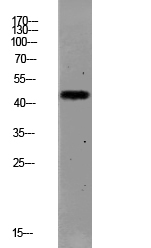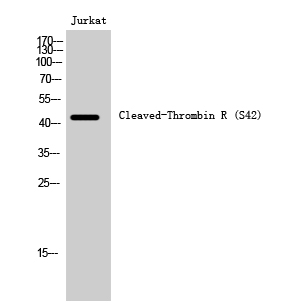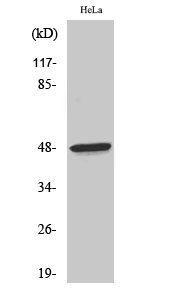Total Thrombin R Cell-Based Colorimetric ELISA Kit
- Catalog No.:KA3394C
- Applications:ELISA
- Reactivity:Human
- Gene Name:
- F2R
- Human Gene Id:
- 2149
- Human Swiss Prot No:
- P25116
- Mouse Swiss Prot No:
- P30558
- Storage Stability:
- 2-8°C/6 months
- Other Name:
- Proteinase-activated receptor 1 (PAR-1) (Coagulation factor II receptor) (Thrombin receptor)
- Detection Method:
- Colorimetric
- Background:
- function:High affinity receptor for activated thrombin coupled to G proteins that stimulate phosphoinositide hydrolysis. May play a role in platelets activation and in vascular development.,PTM:A proteolytic cleavage generates a new N-terminus that functions as a tethered ligand.,PTM:Phosphorylated; probably mediating desensitization prior to the uncoupling and internalization of the receptor.,similarity:Belongs to the G-protein coupled receptor 1 family.,tissue specificity:Platelets and vascular endothelial cells.,
- Function:
- protein import into nucleus, translocation, MAPKKK cascade, activation of MAPKK activity, cell activation, regulation of cytokine production, tissue homeostasis, response to molecule of bacterial origin, healing during inflammatory response, connective tissue replacement during inflammatory response, regulation of transcription, DNA-dependent,protein amino acid phosphorylation, protein targeting, protein import into nucleus, phosphorus metabolic process,phosphate metabolic process, ion transport, cation transport, calcium ion transport, cellular ion homeostasis, cellular calcium ion homeostasis, cellular metal ion homeostasis, intracellular protein transport, nucleocytoplasmic transport,apoptosis, activation of caspase activity, regulation of muscle contraction, regulation of smooth muscle contraction,defense response, inflammatory response, cell surface receptor linked signal transducti
- Subcellular Location:
- Cell membrane; Multi-pass membrane protein.
- Expression:
- Platelets and vascular endothelial cells.
- June 19-2018
- WESTERN IMMUNOBLOTTING PROTOCOL
- June 19-2018
- IMMUNOHISTOCHEMISTRY-PARAFFIN PROTOCOL
- June 19-2018
- IMMUNOFLUORESCENCE PROTOCOL
- September 08-2020
- FLOW-CYTOMEYRT-PROTOCOL
- May 20-2022
- Cell-Based ELISA│解您多样本WB检测之困扰
- July 13-2018
- CELL-BASED-ELISA-PROTOCOL-FOR-ACETYL-PROTEIN
- July 13-2018
- CELL-BASED-ELISA-PROTOCOL-FOR-PHOSPHO-PROTEIN
- July 13-2018
- Antibody-FAQs



